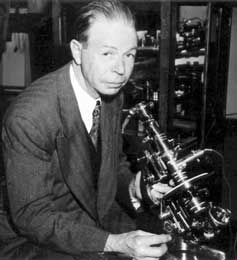History of Electrotherapy
Pain is the symptom which most often causes one to seek out medical care.
Acute pain is pain usually caused by a recent injury or illness, be it physical or psychosomatic. Typically, it helps to alert us when something is wrong. This type of pain usually lasts a few days to months, until the problem which first caused it is resolved. Chronic pain is pain that persists or recurs for a prolonged period of time. This is the type of pain which stems from ailments such as arthritis and other joint problems, certain back conditions, injuries and accidents, and many other problems concerning the nerves, muscles, and bones but also including psychosomatic disturbances. The experience of pain varies widely between individuals, making its exact definition unclear to this day.
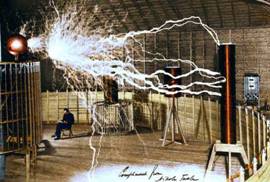 The treatment of pain, naturally, was the first interest in electrotherapy and electromedical research. For centuries electricity has been a challenge to scientists. They have long known that it exists, and have discovered how to generate it on a large scale, but found it difficult to explain exactly what electricity is. That remains even to this day in the orthodox, scientific fields. Around 600 BC, the Greeks found that by rubbing an 'electron' (a hard Fossilized resin that today is known as Amber) against a fur cloth, it would attract particles of straw. This strange effect remained a mystery for over 2000 years, until, around AD 1600, when Dr William Gilbert investigated the reactions of amber and magnets and first recorded the word 'Electric' in a report on the theory of magnetism. Gilbert's experiments led to a number of investigations by many pioneers in the development of electricity technology over the next 350 years.
The treatment of pain, naturally, was the first interest in electrotherapy and electromedical research. For centuries electricity has been a challenge to scientists. They have long known that it exists, and have discovered how to generate it on a large scale, but found it difficult to explain exactly what electricity is. That remains even to this day in the orthodox, scientific fields. Around 600 BC, the Greeks found that by rubbing an 'electron' (a hard Fossilized resin that today is known as Amber) against a fur cloth, it would attract particles of straw. This strange effect remained a mystery for over 2000 years, until, around AD 1600, when Dr William Gilbert investigated the reactions of amber and magnets and first recorded the word 'Electric' in a report on the theory of magnetism. Gilbert's experiments led to a number of investigations by many pioneers in the development of electricity technology over the next 350 years.
The earliest references to the use of electricity in medicine was the use of the Mediterranean torpedo fish, a variety of electric ray. Aristotle and the historian Pliny both referred to the effect of this fish. Scironius Largus described it application for the treatment of gout. Dioscorides, the famous physician who founded the Western Materia Medica, Galen, and Paul of Aegina advised treatment by electric shock from this fish for the treatment of headache.
In 1650, von Guericke built an electrostatic machine containing a sulfur ball rubbed by hand. The first recorded observation of the use of electricity specifically for medical purposes in Europe was attributed to Kratzenstein, professor of medicine at Halle. Jallabert, professor of physics at Geneva , is said to have been the first electrotherapist, for in 1747 he effected some improvement in a locksmith arm that had been paralyzed for 15 years.
Jallabert noted that when sparks were drawn from the arm, muscle contractions were noted.
Read more about electrotherapy pioneers:
Benjamin Franklin
Galvani and Volta
Michael Faraday
Andre Ampere and George Ohm
NIKOLA TESLA & GEORGES LAKHOVSKY
Royal Raymond Rife
Frederick Finch Strong, M.D., Tufts Medical School , Boston
GEORGE CRILE, SR.
ALBERT ABRAMS
HAROLD SAXTON BURR, Ph.D.
 The name of Benjamin Franklin is usually associated with the early application of electric current for therapeutic purposes. Franklin is a well known American writer, publisher, scientist and diplomat, who helped to draw up the famous Declaration of Independence and the US Constitution. In 1752 Franklin proved that lightning and the spark from amber were one and the same thing. The story of this famous milestone is a familiar one, in which Franklin fastened an iron spike to a silken kite, which he flew during a thunderstorm, while holding the end of the kite string by an iron key. When lightening flashed, a tiny spark jumped from the key to his wrist. The experiment proved Franklin 's theory, but was extremely dangerous - He could easily have been killed.
The name of Benjamin Franklin is usually associated with the early application of electric current for therapeutic purposes. Franklin is a well known American writer, publisher, scientist and diplomat, who helped to draw up the famous Declaration of Independence and the US Constitution. In 1752 Franklin proved that lightning and the spark from amber were one and the same thing. The story of this famous milestone is a familiar one, in which Franklin fastened an iron spike to a silken kite, which he flew during a thunderstorm, while holding the end of the kite string by an iron key. When lightening flashed, a tiny spark jumped from the key to his wrist. The experiment proved Franklin 's theory, but was extremely dangerous - He could easily have been killed.
In 1747, Franklin in America and William Watson (1715-87) in England independently reached the same conclusion: all materials possess a single kind of electrical "fluid" that can penetrate matter freely but that can be neither created nor destroyed. The action of rubbing merely transfers the fluid from one body to another, electrifying both. Franklin and Watson originated the principle of conservation of CHARGE: the total quantity of electricity in an insulated system is constant. Franklin defined the fluid, which corresponded to vitreous electricity, as positive and the lack of fluid as negative. Therefore, according to Franklin , the direction of flow was from positive to negative--the opposite of what is now known to be true. Franklin called the travel of electricity positive current, from which we get today the notion of something being positive. Yet, later the electron, the particle accountable for the movement of electricity was labeled to have a negative charge and thus conventions in science changed from positive electron flow, to negative flow. A subsequent two-fluid theory was developed, according to which samples of the same type attract, whereas those of opposite types repel. He further established that laboratory-produced static electricity was akin to a previously mysterious and terrifying natural phenomenon. When the Royal Society in London published these discoveries, and the lightning rods he soon invented appeared on buildings all over America and Europe, Franklin became world famous. He was elected to the Royal Society in 1756 and to the French Academy of Sciences in 1772. His later achievements included formulating a theory of heat absorption, measuring the Gulf Stream , designing ships, tracking storm paths, and inventing bifocal lenses. Franklin learned of results in German and Italy of the use of electroshock treatment for affected limbs. He treated many persons in his Pennsylvania home. On the whole, he considered his results disappointing, admitting he was not a physician. But due to his fame, many static machines were used in Europe for "franklinization".
After Benjamin Franklin came a storm of Electrical Pioneers whose names have become part of our electrical terminology: Luigi Galvani, Alessandro Volta, Nikola Tesla, Andre Ampere, etc. These pioneers conducted many important electrical experiments and derived formulas for its manipulation, generation, and storage. Many others contributed significantly to medical electrotherapy, but their names, stories, and discoveries have largely been suppressed due to the monopolistic conventions being established by the emerging corporate interests, as we shall see...
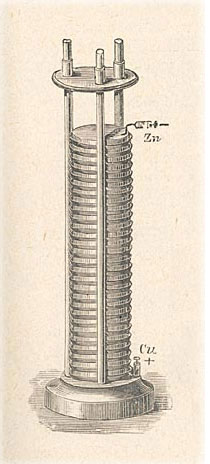 In 1786, Luigi Galvani, an Italian professor of medicine, found that when the leg of a dead frog was touched by a metal knife, the leg twitched violently. Galvani thought that the muscles of the frog must contain electricity.He concluded that the twitching was evidence for the existence of animal electricity.''By 1792 another Italian scientist, Alessandro Volta, disagreed: he realized that the main factors in Galvani's discovery were the two different metals - the steel knife and the tin plate - upon which the frog was lying.
In 1786, Luigi Galvani, an Italian professor of medicine, found that when the leg of a dead frog was touched by a metal knife, the leg twitched violently. Galvani thought that the muscles of the frog must contain electricity.He concluded that the twitching was evidence for the existence of animal electricity.''By 1792 another Italian scientist, Alessandro Volta, disagreed: he realized that the main factors in Galvani's discovery were the two different metals - the steel knife and the tin plate - upon which the frog was lying.
Volta showed that when moisture comes between two different metals, electricity is created. This led him to invent the first electric battery, the voltaic pile, which he made from thin sheets of copper and zinc separated by moist pasteboard.
In this way, a new kind of electricity was discovered, electricity that flowed steadily like a current of water instead of discharging itself in a single spark or shock. Volta showed that electricity could be made to travel from one place to another by wire, thereby making an important contribution to the science of electricity. The unit of electrical potential, the Volt, is named after Volta . It will be smart of you to think of electricity like water flowing in a pipe. The amount of water or mass is called volts, while its rate of flow is called amps, or like water, pounds per square inch. The old saying in medical electronics is volts shock, but amps kill.
As electrons bounce along through the wire, the general charge drift constitutes the current. The average, or drift, speed is defined as the speed the electrons would have if all were moving with constant velocity parallel to the field. The drift speed is actually small even in good conductors. In a 1.0-mm-diameter copper wire carrying a current of 10 amps at room temperature, the drift speed of the electrons is 0.2 mm per second. Yet, in copper, the electrons rarely drift faster than one hundred-billionth the speed of light..
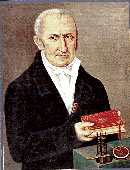
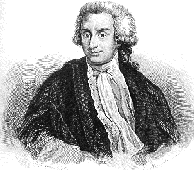
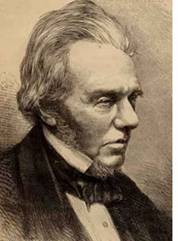 The credit for generating electric current on a practical scale goes to the famous English scientist, Michael Faraday. Faraday was greatly interested in the invention of the electro- magnet, but his brilliant mind took earlier experiments still further. If electricity could produce magnetism, why couldn't magnetism produce electricity? In 1831, Faraday found the solution. Electricity could be produced through magnetism by motion. He discovered that when a magnet was moved inside a coil of copper wire, a tiny electric current flows through the wire.
The credit for generating electric current on a practical scale goes to the famous English scientist, Michael Faraday. Faraday was greatly interested in the invention of the electro- magnet, but his brilliant mind took earlier experiments still further. If electricity could produce magnetism, why couldn't magnetism produce electricity? In 1831, Faraday found the solution. Electricity could be produced through magnetism by motion. He discovered that when a magnet was moved inside a coil of copper wire, a tiny electric current flows through the wire.
He discovered, in essence, the first method of generating electricity by means of motion in a magnetic field, yet Otto Von Guericke made the first electrical machine, the frictional machine, by which a glass ball of sulphur became electrified by rotating rubber. Davy, who had the greatest influence on Faraday's thinking, had shown in 1807 that the metals sodium and potassium can be precipitated from their compounds by an electric current, a process known as ELECTROLYSIS.
Faraday's vigorous pursuit of these experiments led in 1834 to what became known as Faraday's laws of electrolysis.
Faraday's research into electricity and electrolysis was guided by the belief that electricity is only one of the many manifestations of the unified forces of nature, which included heat, light, magnetism, and chemical affinity.
Although this idea was erroneous, it led him into the field of electromagnetism (see MAGNETISM), which was still in its infancy. In 1785, Charles Coulomb had been the first to demonstrate the manner in which electric charges repel one another, and it was not until 1820 that Hans Christian OERSTED and Andre Marie AMPERE discovered that an electric current produces a magnetic field.
Faraday's ideas about conservation of energy led him to believe that since an electric current could cause a magnetic field, a magnetic field should be able to produce an electric current. He demonstrated this principle of INDUCTION in 1831. Faraday expressed the electric current induced in the wire in terms of the number of lines of force that are cut by the wire. The principle of induction was a landmark in applied science, for it made possible the dynamo, or GENERATOR, which produces electricity by mechanical means.
Andre Ampere and George Ohm
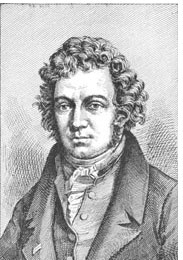 Andre Marie Ampere, a French mathematician who devoted himself to the study of electricity and magnetism, was the first to explain the electrodynamic theory. A permanent memorial to Ampere is the use of his name for the unit of electric current.
Andre Marie Ampere, a French mathematician who devoted himself to the study of electricity and magnetism, was the first to explain the electrodynamic theory. A permanent memorial to Ampere is the use of his name for the unit of electric current.
George Simon Ohm, a German mathematician and physicist, was a college teacher in Cologne when in 1827 he published, "The galvanic Circuit Investigated Mathematically". His theories were coldly received by German scientists but his research was recognized in Britain and he was awarded the Copley Medal in 1841. His name has been given to the unit of electrical resistance, the ohm.
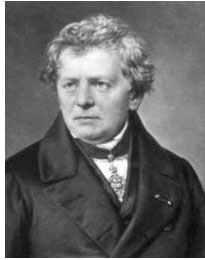
The possibility that electricity does not consist of a smooth, continuous fluid probably occurred to many scientists. Even Franklin once wrote that the "fluid" consists of "particles extremely subtile." Nevertheless, a great deal of evidence had to be accumulated before the view was accepted that electricity comes in tiny, discrete amounts, looking not at all like a fluid when viewed microscopically. James Clerk Maxwell opposed this particle theory. Toward the end of the 1800's, however, the work of Sir Joseph John THOMSON (1856-1940) and others proved the existence of the ELECTRON.
Thomson had measured the ratio of the electron's charge to its mass.
Then in 1899 he inferred a value for the electronic charge itself by observing the behavior of a cloud of tiny charged water droplets in an electric field. This observation led to Millikan's famous Oil-Drop Experiment. Robert MILLIKAN, a physicist at the University of Chicago , with the assistance of his student Harvey Fletcher, sought to measure the charge of a single electron, an ambitious goal in 1906. A tiny droplet of oil with an excess of a few electrons was formed by forcing the liquid through a device similar to a perfume atomizer. The drop was then, in effect, suspended, with an electric field attracting it up and the force of gravity pulling it down. By determining the mass of the oil drop and the value of the electric field, the charge on the drop was calculated. The result: the electron charge -e- is negative and has the value e = 1.60/10,000,000,000,000,000,000 coulombs.
This charge is so small that a single copper penny contains more than 10,000,000,000,000,000,000,000 electrons.
Bulk matter is normally neutral. The tendency is for every positive proton in an atom to be electrically balanced against a negative electron, and the sum is as close to zero as anyone has been able to measure. In 1911, Ernest RUTHERFORD proposed the nuclear ATOM. He suggested that electrons orbit a positively charged nucleus less than 1/100,000,000,000,000 meters in diameter, just as planets orbit the Sun. Rutherford also suggested that the nucleus is composed of PROTONS, each having a charge +e. This view of matter, still considered correct in many ways, established the electrical force as that which holds an atom together. After Rutherford presented his atom, the Danish physicist Niels BOHR (see the book PHOTOBIOTICS) proposed that the electrons have only certain orbits about the nucleus, that other orbits are not possible.
The 19th century saw great strides in the advancement of electrical knowledge. Almost all the systems we use today for electrical production and transmission of power were developed by then - oil-filled capacitors (line transformers next to your house), 3-phase power (220 volt), high voltage tension lines, etc. had been invented by Tesla...
Greatest Electrical Pioneer of all was Nikola Tesla, who was brilliant inventor despite the fact that he had little formal education. Nikola (1856-1943), electrical inventor, was born in Yugoslavia, educated at the polytechnical school at Graz and at University of Prague . He conceived new type of electric motor having no commutator, as d.c. motors have, but works on principle of rotating magnetic field produced by polyphase alternating currents.
Constructing a prototype, he found nobody interested in Europe. Emigrated to U.S. 1884 and worked briefly and unhappily with Thomas Edison. He established own lab and obtained patents on polyphase motors, dynamos, transformers for a complete a.c. power system. He formed an alliance with George Westinghouse, who bought polyphase patents for $1 million plus royalty. With Westinghouse, engaged in struggle against Edison to convince public of efficiency and safety of a.c. over d.c. He succeeded in getting a.c. accepted as the electric power system worldwide which remains to this day.
Also with Westinghouse, he lit the Chicago World's Fair with fluorescent lamps, he built Niagara Falls hydropower plant, and installed systems at Colorado silver mines, other industries. By turn of the century was lifted to celebrity status comparable to Edison 's as media promoted him along with the expanding electric power industry. Experimenting independently in his Manhattan lab, he developed and patented scores of electric devices based on his superior capabilities of high-potential, high-frequency currents: Tesla coil, radio, high-frequency lighting, x-rays, and most importantly germane to our topic - electrotherapeutic devices.

Nikola Tesla inside Colorado springs station
His High-frequency inventions were ignored by established technology, as were disk turbine, free-energy receiver, other inventions. Shut out by media except for birthday press conferences. At these predicted microwaves, TV, beam technologies, cosmic-ray motor, interplanetary communications, and wave-interference devices that since have been named the "Tesla howitzer" and the "Tesla shield." In the 1930's he was involved in wireless power
projects in Quebec . His last birthday media appearance was in 1940. He died privately and mysteriously at 87 in New York hotel room from no apparent cause. Personal papers, including copious lab notes, impounded by U.S. Government, surfaced many years later at a Tesla Museum in Belgrade , Yugoslavia . Of these notes, only a fragment, Colorado Springs Notes, has been published by the Museum.
Another one of the electrical engineers was a Russian emigrant, Georges Lakhovsky who made observations of the effects of electricity and radio waves on living organisms. His first book, THE SECRET OF LIFE, was first published in 1935 during the same month Hitler drove his hordes into Prague . The book appeared later in Spanish, French, Italian, and finally in English.
Many of his theories were, of course, ignored in conventional medicine as in 1938, the Flexner Committee reported to the US Congress it report on medical education and branded electrotherapy as "quackery". Many of Lakhovsky's theories were only recently confirmed by Becker in his book THE BODY ELECTRIC, published in 1987.
The Italians were the first investigators to seriously study his new science, RADIOBIOLOGY, and put it to the test in laboratories and clinics. It resulted in astonishing photographs of regenerated tissues in plants and human beings. It became indisputable fact that Lakhovsky was the first serious, scientific investigator on the use of high-frequency electromagnetic waves in biology. The first international Congress of Radiobiology was held in Venice in 1934. A leading authority on electrotherapy, Dr. E.P. Cumberbatch wrote: Although it had frequently been observed that the short Hertzian waves could produce heat at a distance from the transmitter, the first scientific investigation from a biological point of view was made by Lakhovsky and his colleagues who published a paper in 1924 on the effects of very short waves on cancer in plants. Mark Clement later wrote: "In this country, owing mainly to the inauspicious time at which Lakhovsky's major work was published, very little interest has been shown on the part of those best qualified to judge of its merits. The medical profession, whose conservatism is the most formidable barrier to progress, has been notoriously slack in investigating the new radiobiological methods of treating disease as originated by Lakhovsky."
Lakhovsky built a device called the multiple wave oscillator, which today is the basis of for electrotherapy technology. Lakhovsky's first units were built on the basis of the Arsonval effect, low voltage, high current coil transmission. The units were bulky and naturally ran hot. In 1931, frustrated with the design, he asked Tesla for help in design, which he complied. Tesla traveled to Europe where the friendship was established.
Ten years later Lakhovsky traveled to New York City to visit his friend Tesla. Lakhovsky was mysteriously hit by a limousine and knocked high into the air. The three men in the limousine took Lakhovsky to a hospital against his demands to be left alone. Three days later he died in the hospital. Who only knows the rest of the story?
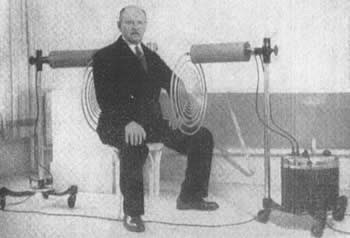
Royal Raymond Rife
** Revolution in Electrotherapy devices for the 20th century
Royal Raymond Rife , born in 1888, was one of the greatest scientific geniuses of the 20th century. He began researching a cure for cancer in 1920, and by 1932 he had isolated the cancer virus. He learned how to destroy it in laboratory cultures and went on to cure cancer in animals. In 1934, he opened a clinic which successfully cured 16 of 16 cases within three months time. Working with some of the most respected researchers in America along with leading doctors from Southern California , he electronically destroyed the cancer virus in patients, allowing their own immune systems to restore health.
The University of Southern California sponsored a Special Medical Research team years ago, to evaluate this electronic therapy on the terminally ill. After 130 days, EVERY PATIENT in the study had recovered without side effects of any kind. The medical team which evaluated the therapy for the University of Southern California included: Rufus Klein-Schmidt (President, Univ. of Southern California ), Milbank Johnson (then the President of the southern Calif. AMA), Arthur Kendall (Director, Northwestern Medical School), Edward Kopps (Metabolic Clinic, La Jolla), George Fischer (Children's Hospital, NY), Karl Meyer (Hooper Found., San Francisco), Whalen Morrison (Chief Surgeon, Sta. Fe Railway), George Dock.
Royal Raymond Rife was perhaps the most brilliant and persistent scientist in history. Where technology didn't exist, Rife invented it ---the very first micromanipulators, micro-dissectors, and heterodyning ultraviolet microscopes. He won 14 govt. awards for scientific discoveries, and a medical degree (hon.) from the University of Heidelberg.
Millionaires like Henry Timken financed Rife's work, such as the Universal Microscope, with its 5,682 parts. With this superb microscope, Royal Raymond Rife became the first human being to actually see a virus. After nearly 20,000 unsuccessful attempts, Rife finally isolated and identified the human cancer virus, and named it "Cryptocides Primordiales". Rife inoculated 400 lab animals with this virus, created 400 tumors, and then eliminated every cancer tumor by using his instrument to modify its electronic signature. This is all chronicled in "The Cancer Cure That Worked".
Rife used the same technology for other "incurable" diseases. Constructing his own equipment, he painstakingly analyzed the precise energetic signature unique to each. Because the viruses and dwarf bacteria visible to the human eye in Rife's Universal Microscope were alive, stained with light, not dyes, Rife could experiment with precise radio and light frequencies or "wave form healing," and destroy these deadly pathogens under his microscope. By exposing disease organisms to highly modified forms of their own unique electromagnetic pattern of oscillation, Rife discovered he could destroy them (and nothing else) by the millions. How is this possible? Every biochemical compound oscillates at its own distinct frequency pattern. Therefore, every living thing has its own unique electromagnetic signature, and this pattern is genetically determined--and thus unlike any other species.
After decades of research, Rife isolated the patterns, modified them and used them to kill the microbes that produced them! Just as a wine glass is shattered only by a particular frequency, so Rife's frequencies destroy only the disease organism whose oscillation pattern corresponds to the modified pattern he broadcast. Therefore, RIFE THERAPY IS ONE OF THE VERY FEW ANTIMICROBIAL THERAPIES KNOWN TO BE FREE OF ANY SIDE EFFECT. Unfortunately, Rife's scientific theories and method of treatment conflicted with orthodox views and that of Morris Fishbein, then president of the AMA who demand to own stock in his company. When he refused, his work was stopped and both the research and the treatments were forced underground as the story goes in Barry Lynes book THE CANCER CURE THAT WORKED, FIFTY YEARS OF SUPPRESSION. And nothing has changed recently. These are just a few of the distinguished medical doctors who have been harassed and persecuted in the last 50 years for discoveries that threatened the health care industry - Doctors Revici's work on nutrition and cancer , Dr. Burzynski's work on immune therapy and cancer, Dr. Livingston's findings of cancer pathogens in chicken meat, Dr. Burton's work on immune therapy and cancer, W.F. Koch and Glover's works reported in our Course on Balneology, Coley's and Lincoln's cancer vaccines, Priore and Naessens, both French scientists.
This electronic technology was buried for years. Rife's lab assistant, John Crane made himself public. He got the notion that transdermal frequency would provide better and more accurate delivery since frequencies transmitted through air would alter when hitting the body's skin, a well known dielectric. He initial theory was true. He proposed and advanced the use of transdermal stimulators. He used simple frequency generators. Recently resurrected, and is once again available, are scores of such devices on the market.
Frederick Finch
Frederick Finch Strong, M.D., Tufts Medical School, Boston
Another unsung hero of electrotherapeutics was the late Dr. Strong. He was an eclectic and metaphysician who lectured on Cosmic Forces and vital force as the principal of existence for the bodies of plants, animals, and humans, stating - We have no name for this force, but through its action the great cosmic scheme of evolution goes on. In India they call it by a Sanskrit name - prana... In 1893, Nikola Tesla described in a magazine article the remarkable effects upon himself and his assistants resulting from their exposure to the action of alternating currents of exceedingly high voltage and frequency during some research work. He prophesied that when electrical oscillations were fully understood and applied by physicians that a universal healing agent - one which would so increase the vital energy and resistive reaction of the human body as to enable it to throw off all disease... The high frequency currents, in short, act as vitality boosters - no other form of electricity will do this. Galvanism, Faradism, Static electricity are all valuable agents in the hands of the Electrotherapeutic specialist, but have little direct action in promoting cell vitality and growth, as do the high-frequency currents when properly applied.

Strong demonstrating the appearance of the human aura when exposed to high voltage, high frequency current with the aid of psychic perception or by which the person can see by gazing through special cyan chemical filters.
 The famous physician who was one of the founders of the famous Cleveland Clinic, worked for nine years formulating the all but forgotten bipolar theory of living processes. The works he did on the body's bioelectrical energies were truly monumental as was his work on the cause of surgical shock. He established the technique and value of the blood transfusion. During his long search for the underlying causes of fatigue, exhaustion and death at work in the University College of London, war hospitals in France, and the Western Reserve University Medical School, his data made it apparent that in order to understand the cause of surgical shock and death, it was necessary to understand the body as an electric potential. That is, the maintenance of the acid medium of the nucleus and the alkaline medium of the cytoplasm. His histological findings concluded that the “lipoid films surrounding the nucleus and the cytoplasm offered a definite resistance to the positive hydrogen ions and that in death this resistance is lowered.
The famous physician who was one of the founders of the famous Cleveland Clinic, worked for nine years formulating the all but forgotten bipolar theory of living processes. The works he did on the body's bioelectrical energies were truly monumental as was his work on the cause of surgical shock. He established the technique and value of the blood transfusion. During his long search for the underlying causes of fatigue, exhaustion and death at work in the University College of London, war hospitals in France, and the Western Reserve University Medical School, his data made it apparent that in order to understand the cause of surgical shock and death, it was necessary to understand the body as an electric potential. That is, the maintenance of the acid medium of the nucleus and the alkaline medium of the cytoplasm. His histological findings concluded that the “lipoid films surrounding the nucleus and the cytoplasm offered a definite resistance to the positive hydrogen ions and that in death this resistance is lowered.
Crile believed that “the animal organism as a whole is enmeshed in a network of highly specialized electric conductors - namely, the nervous system. In its physical composition, therefore, the body is not only highly adapted to electrical properties but its constituents in their interrelations within the organism could not be of any conceivable value in a mechanism operated by other forms of energy... We may consider then that electricity keeps the flame of lifeburning in the cell; and that the flame (oxidation) supplies the electricity which is the vital force of the animal... We may therefore consider the cell as a bipolar mechanism, the nucleus being positive element, the cytoplasm the negative element. The oxidation in the nucleus appears to be on a higher scale than the oxidation of the cytoplasm; and therefore as the electric tension increases in the nucleus, the current breaks through; the potential in the nucleus falls and in consequence the current is interrupted. Since the potential is again immediately restored by oxidation, we conceive that the interrupted current passes continually from the positive nucleus to the negative cytoplasm and in consequence a charge is accumulated on the surface films. These films of infinite thinness and of high dielectric capacity are peculiarly adapted to the storage and adaptive discharge of electric energy... There is no more energy per mass in the living than in the non-living. In the living, energy is captured and stored and made to run the organism - in the non-living the same amount of energy exists, but is balanced; equalized; inert; non-living
His works and perceptions were nothing short of genius. What he called the Quest in his book THE PHENOMENA OF LIFE, A RADIO ELECTRIC INTERPRETATION (1936) was to find the cause and correction of death by surgical shock. After ten years of experimentation his states: According to our findings, the maintenance of the acid-alkali balance between the nucleus and cytoplasm of the cells - the electric potential - is essential to life and furnishes the immediate driving energy of the living process itself. Its reduction to zero or equilibrium is death... In structure and function the unit cells which drive the organism must be adapted to generate and to release radiation and electricity... The mechanism by which oxidation within the protoplasm of the cell generates the electric charges that operate the cell and the organism we postulate is due to the short wave radiation generated and emitted by oxidation within the protoplasm.
 The beginning of the century was the dawn of the era of the radio frequency age. It grew out of war technology and its suppression in medicine was due to its war mentality, that is, microbes invading the body had to be killed, diseased glands surgically removed, and any innovations and challenges to medical war mentality, had to be suppressed and eradicated. Medicine as we know it, is thus an art form at war with the human body in many of its aspects.
The beginning of the century was the dawn of the era of the radio frequency age. It grew out of war technology and its suppression in medicine was due to its war mentality, that is, microbes invading the body had to be killed, diseased glands surgically removed, and any innovations and challenges to medical war mentality, had to be suppressed and eradicated. Medicine as we know it, is thus an art form at war with the human body in many of its aspects.
Thus we had such new terms as antibiotics, antimicrobials, antifungals, antiparasiticals, antibodies, anticoagulant, anticholinergic, antihistamine, antiperspirant, etc. Anti means against, bios means life. Thus, the widespread use of antibiotics, in humans and animals, has fulfilled its mantic functions.
Many physicians were open to study any method new and of benefit to their patients. That included a field called Radiotherapy. Radiotherapy as defined, not only includes the application of X-rays, but other forms of radiant energy. In our case, specifically, radio waves, as defined are those electromagnetic waves at a frequency lower than 3000 gigahertz. And that is specifically the waves dealt with in our application. Radionics, as it was called in its original inception, was the science of detecting, measuring, and utilizing microenergetic emanations which radiate from matter. Today, this would be called nanotechnology. The way in which radionics originated is in itself a fascinating story, but what is even more mysterious is how this simple, yet potent therapy was apparently eradicated from the planet.
The concept of radionics was very simple: all matter emanates radio waves as part of its atomic makeup. The human body generates radio waves which can be detected and treated. When an organ or gland became diseased, its radio waves are thus altered. These could be effectively neutralized by picking them up on the skin, amplifying and inverting them 180 out-of-phase, returned to the patient, which effectively removed the diseased waveforms. Many saw this as the mechanism as to how homeopathic remedies worked, and how liked cured liked.
This same technology is extensively utilized in the acoustic and electronic fields. The methods go by many names such as phase equalizer, phase inversion, and phase modulation. Its application in sound technology is utilized in automobiles, aircraft, architecture, etc., or just about anywhere the reduction and suppression of noise is of benefit. How this well known phenomena of wave cancellation was lost as a form of physical therapy escapes anyone of sane and sound mind. This form of treatment was the original proposition of the school of Pathometry , as developed originally by Dr. Albert Abrams (M.D. surgeon in San Francisco ), and later by Dr. Ruth Drown, Wiggelsworth, Jones, Goodheart, and other physicians. Radionics evolved from a form of "percussive" diagnosis used during the Middle Ages wherein the abdomen was "thumped" and a dull tone indicated the area where an organ was operating in a disharmonious state. At the beginning of this century Albert Abrams, a distinguished and highly regarded American physician, modified this technique to where a subject's abdomen was "rubbed" with glass to find a disharmonious area. In the glass-rubbing form of diagnosis Abrams would rub a glass rod around the subjects abdomen until a "stickiness" was felt. Note that Abrams was not looking for something specific, like water or gold, but rather was feeling around for problems with a subject's energetic state of being.
He then began placing biopsied specimens in circuit with the patient and noticed changes with the stickiness of the glass rod. This action of resonance created a dragging effect by virtue of electrostatic energy. It came to be known as the Abrams Reaction. He became convinced that the frequencies involved were radio waves and that equipment could be developed toward the goal of neutralizing and eliminating disease radiations by electronic means. Due to his family's wealth and his status as a medical doctor, he built a laboratory to dedicate his ideas full-time.
Abrams found that each person had their own peculiar structure, or energetic fingerprint. To be accurate in diagnosis he used a healthy control subject, whose reactions he became familiar with, and connected them via a single wire to the test subject. He discovered that the energies of the test subject were transmitted along the wire and manifested in his control subject. It was found that a variable resistance placed into this single wire circuit allowed him to keep the wire in one place on the body while changing the resistance. It was discovered that a specific setting of the resistance related directly to an organ's position and status in the body. Abrams further modified this technique to where he took a glass plate, placed a coil underneath it, and connected the coil to the wire and resistance circuit. He discovered that he could get the "sticking" reaction on the glass plate, just as the glass rod rubbers could feel a disharmonious area on the body.
Abrams discovered he could use a patient's blood sample connected to the circuit, and achieve the same bioenergetic connection. Ruth Drown, a Los Angeles Chiropractor well known as a radionic pioneer, circa late 1930s to early 1960s, modified this to where she used a blood crystal like a detector in a crystal radio. She also hooked patients physically into circuits for diagnosis and treatment.
Radionics instruments consist generally of a circuit of resistors or capacitors arranged in a specific pattern or order, which provides a stable system of "rates" which may be dialed in to set the instrument for various organs or disease patterns. This now has been recently verified by Dr. Cyril Smith of Salford University . He has demonstrated that allergic subjects may develop allergic symptoms not only to the presence of a sealed allergen in a glass tube but also to the frequency transmissions of the same allergen generated by means of an electronic resonator. It is evident that it is the physical vibrational properties of matter rather than their chemical properties which are at work with allergens. Could this same observation confirm Lakhovsky's theory that the body can only be infected by pathogens when its radiations wane in power and that by vibrating the body back to optimum quanta, the pathogens have no way to persist ?
Harold Saxton Ph.D
 Harold Burr was professor emeritus of anatomy at Yale University School of Medicine. He became convinced that the glue holding bodies in shape through their ceaseless metabolism and changes of material was an electrodynamic field or matrix he called the L-field. Harold Saxton Burr in 1935 described a system of electro-dynamic fields. He worked with the electromagnetic currents in the bodies of salamanders and then in humans which he finally named Lfields (life fields). Robert Becker reconfirmed Burr's work recently and applied DC current to regenerating salamander tails and healing human bone fractures. In his work with the National Institutes of Health (NIH) Becker clarified that the perineural (nerve sheath) network is highly conductive.
Harold Burr was professor emeritus of anatomy at Yale University School of Medicine. He became convinced that the glue holding bodies in shape through their ceaseless metabolism and changes of material was an electrodynamic field or matrix he called the L-field. Harold Saxton Burr in 1935 described a system of electro-dynamic fields. He worked with the electromagnetic currents in the bodies of salamanders and then in humans which he finally named Lfields (life fields). Robert Becker reconfirmed Burr's work recently and applied DC current to regenerating salamander tails and healing human bone fractures. In his work with the National Institutes of Health (NIH) Becker clarified that the perineural (nerve sheath) network is highly conductive.
B.E.W. Nordenstrom has described the Vascular interstitial closed circuit as a system of preferential ion conductance pathways comprising a network of biological circuitry. There is some suggestion that even more subtle energies resonate in the human system and may be projected over substantial distances as was shown by radionic practitioners like Drown and Hieronymus.
Burr was able to show some amazing studies, e.g. a malignancy in the ovary was revealed by its L-Field before any clinical signs could be observed. He showed that the L-field matrix in a frog's egg outlined the developmental growth of the entire nervous system. He states: Nature keeps an infinite variety of electro-dynamic jelly-moulds on her shelves with which she shapes the countless different forms of life that exist on this planet... L-fields are detected and examined by measuring the difference in voltage between two points on - or close to - the surface of a living form... They are pure voltage potentials which can yield only an infinitesimal amount of direct current. That is why L-fields could not be detected before the invention of the vacuum-tube voltmeter, which requires virtually no current for its operation.
Burr researched L-fields for over 40 years and published extensively, e.g. Yale Journal of Biological Medicine. He was completely ignored by the medial community and his work is never mentioned in any standard textbooks on biology. His book, Voyage of Discovery, was published in London in 1972.
